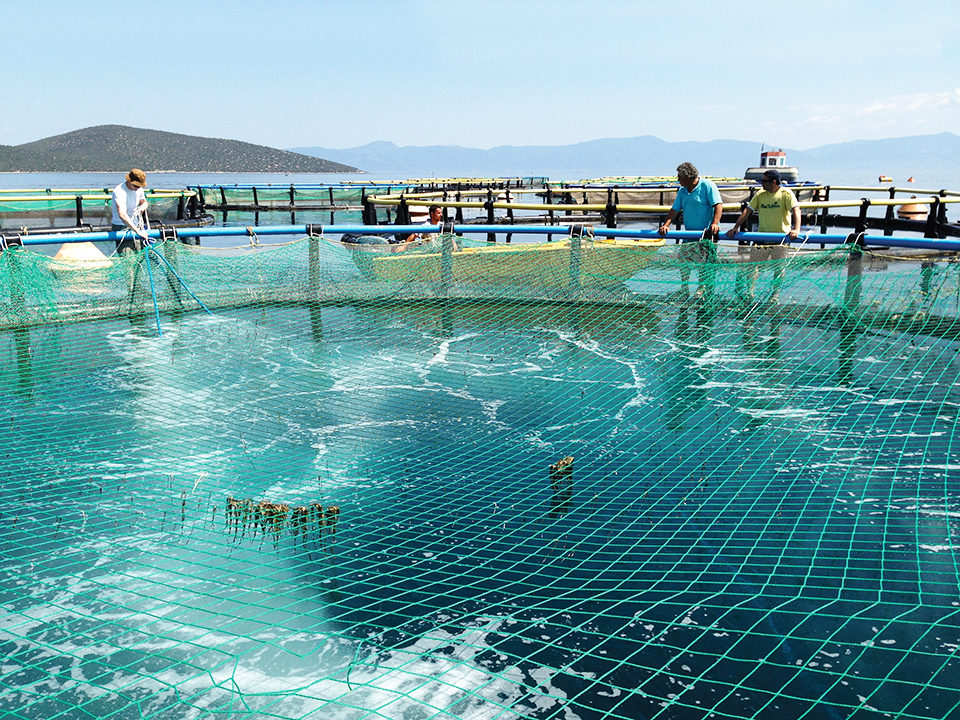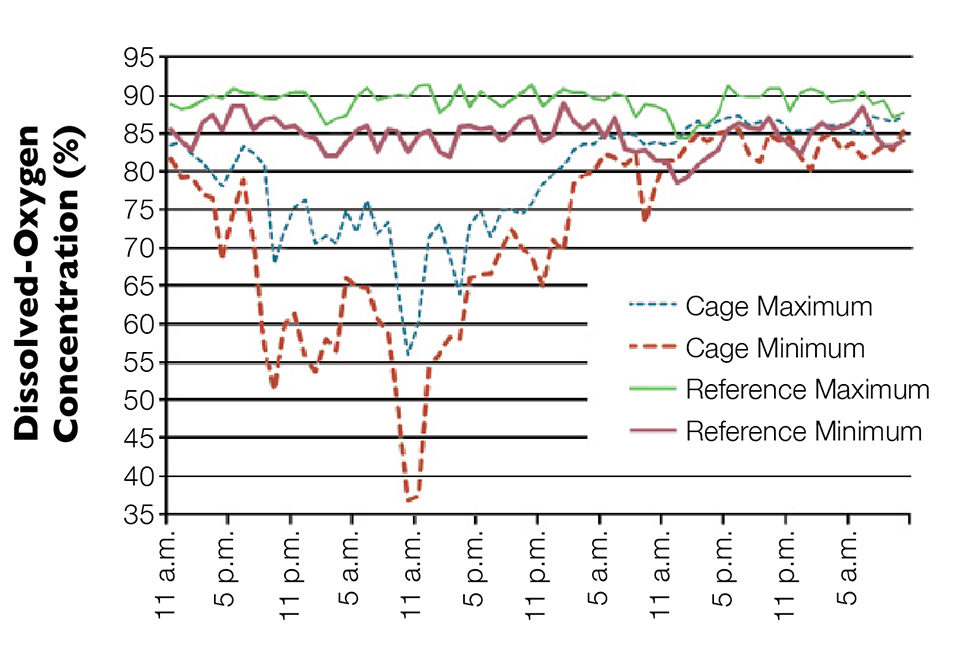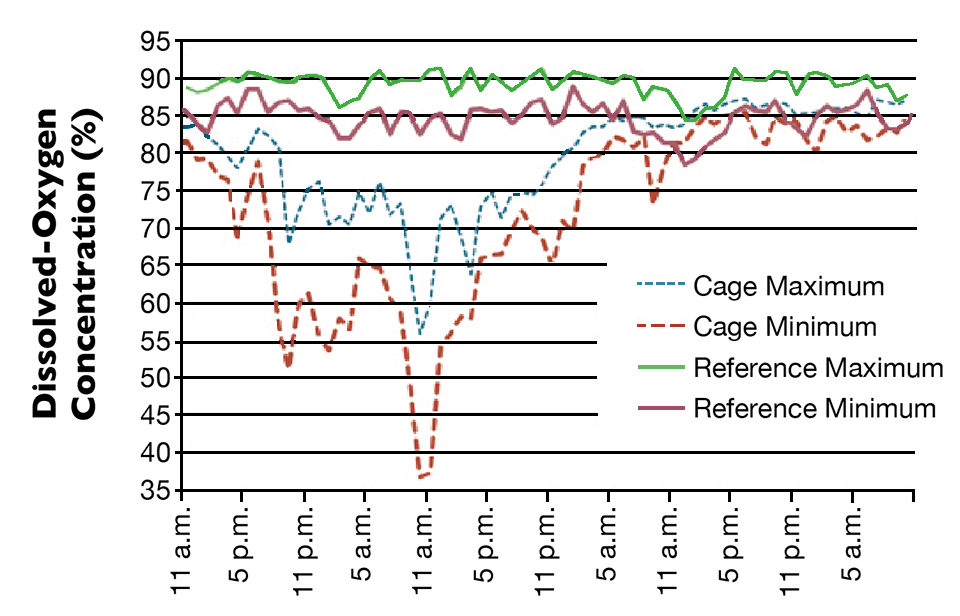Oxygen demand increases with rising temperatures

Dissolved oxygen in culture water is considered one of the dominating limiting factors in aquaculture. However, suboptimal dissolved-oxygen (D.O.) levels are experienced periodically during the warm season in many fish and shrimp farms.
Low oxygen supply capacity during this critical period generally limits the production level of the farms.
Oxygen control crucial
The oxygen demand in aquaculture systems increases markedly with rising temperature. This is caused by two well-known factors. The solubility of dissolved oxygen is reduced with increasing temperature, making less oxygen available for the fish or shrimp. In addition, the oxygen consumption rate of the stock increases concurrently with the temperature.
As an example, a temperature increase from 15 to 25 degrees-C in water with 35- to 40-ppt salinity results in reduced solubility of D.O. from c. 8 to c. 6 mg/L, and more than doubled oxygen consumption by the farmed stock. In sea bass and sea bream culture, this means at least five to 10 times more oxygen would be needed to support the fish at 25 than at 15 degrees-C, assuming a similar water-exchange rate.
It has been documented at numerous extensive and semi-intensive cage and pond farms that early-morning D.O. deficits, especially in late summer and early autumn at high water temperatures, strongly limit production. Thus, oxygen injection during the night is a key factor to improve farm productivity.
In intensive culture with greater fish stocking and lower flow rates, aeration should be employed throughout the day during warm seasons. Without a sufficient oxygen supply, the welfare of the cultured stock is put at risk. Insufficient D.O. can eventually lead to reduced growth, disease outbreaks and mortality.
Efficient aeration
Oxygen can be injected into water by the use of pure oxygen, oxygenation or air aeration. In general, oxygenation is more costly than aeration, as the production of oxygen gas is energy-demanding. Hence, aeration is often preferred to oxygenation in land-based shrimp and fish farming. A common practice in pond and raceway culture today is to add oxygen by use of surface aerators, such as paddlewheels, propeller-aspirator pumps and air injectors. These types of surface aerators combine oxygen injection and water circulation.
Diffuser-based aerators are also sometimes used, with air injected from the pond bed level using blowers that supply air at low pressure. A major advantage of submerged diffusers is the possibility to create a large interface with the water body as the air is slowly rising to the surface. The choice of aerator and routine operation of the device are decisive factors for the functionality of the aeration in achieving increased fish production at reasonable cost.
The main cost element for D.O. control by aeration is normally electrical consumption, which must be balanced against the aerator’s ability to transfer oxygen to the water. In general, surface aerators like paddlewheels loose a high amount of kinetic energy throwing the water into the air. Their reported transfer efficiency is as low as 1-2 kg oxygen/kWh. Submerged membrane diffusers with transfer efficiencies of 2 to 3 kg oxygen are more efficient. Efficiencies above 5 kg oxygen/kWh have been reported for fine-bubble diffusers.
Lab-Scale diffuser testing
The AirX project is developing a new air diffuser-based system for the control of dissolved-oxygen levels in fish and shrimp culture. Patented by the Norwegian company Oxyvision, the aeration concept is designed for use in large rearing units and is presently being employed and tested in sea cages and earth ponds in the Mediterranean region. The project is funded through the European Union’s 7th Framework Programme and will run until the end of 2014.
As a basic part of the AirX project, experimental tests have been carried out to maximize the efficiency of submerged diffusers for aeration in ponds and cages. At Oxyvision’s laboratory, oxygen transfer efficiency in a seawater tank without fish was monitored by combining a range of diffuser prototypes with different characteristics. The test procedure also involved combinations of air pressure and the resulting air flow.
In each test, the transfer rate was frequently measured throughout the injection period from 10 to 30 percent and 80 to 100 percent of dissolved-oxygen saturation. The oxygen transfer rate was calculated for each test and converted to the standard rate at 20 degrees-C. Based on the measured transfer rate and the electricity consumption, the standardized aeration efficiency (SAE) can be calculated in terms of how much oxygen is transferred per kWh.
In the lab, an SAE of 2.7 kg oxygen/kWh was calculated for the best test diffuser at low air pressure. Compared to reported transfer rates in aerated ponds with raceways for freshwater fish production, the small-scale tests in lab indicated promising efficiency.

Aeration in Mediterranean cages
Whereas aeration is common practice and considered vital in many land-based culture operations, traditional sea cage culture still typically relies on natural water exchange by currents to replace oxygen that is consumed by the fish. In late summer and early autumn, an unfavorable combination of high temperatures over 30 degrees-C, subcritical low oxygen concentrations and increased biomass in the cages often leads to periods during which farmers must stop or reduce feeding.
This situation can lead to increased stress, lower appetite and digestive capacity for the animals, disease outbreaks and even increased mortalities. However, such seasonally unfavorable conditions are sparsely described beyond the obvious problems for the industry.
Monitoring of variations in oxygen levels was therefore carried out at a commercial cage farm in Greece as a part of the AirX project. About 20,000 sea bass (Dicentrarchus labrax) of average individual size of 550 grams were stocked in a cage of 40-meter circumference and 8-meter depth. The total biomass of the fish was about 11 metric tons, and the stocking density was 11 kg per cubic meter. An oxygen sensor was placed outside the cage and another sensor was positioned inside the cage at 3-meter depth.

In addition, a current velocity sensor was installed at the site. The dissolved-oxygen saturation reached a low level some hours after feeding in tests done in November 2012. The fish were hand fed only during the morning hours from 8 a.m. to noon. In some cases, the level of oxygen was lower than 40 percent oxygen saturation (Fig. 1). This critical level was linked with limited water currents in the area (Fig. 2). This clearly demonstrated the risks even when water temperature was no more than 20 degrees-C. The situation may therefore get far more dangerous earlier in the year, when water temperatures can be as high as 30 degrees-C.
Prospective field trials in ponds
The AirX diffuser system is also presently being tested in earth ponds in Portugal. Parameters such as dissolved-oxygen levels and pond sediment accumulation and characteristics are routinely monitored. The performance of the fish stock will be balanced against the costs of the aeration and assessed against controls when trials are finalized in the end of 2014.
(Editor’s Note: This article was originally published in the May/June 2014 print edition of the Global Aquaculture Advocate.)
Authors
-
-
Dr. Asbjørn Bergheim
International Research Institute of Stavanger
Stavanger, Norway -
Dr. Pavlos Makridis
University of Patras
Patras, Greece -
Martin Gausen
OxyVision A.S., Norway
Related Posts

Aquafeeds
Aquaculture feed composition helps define potential for water pollution
A study found that feed for salmon and trout had higher organic carbon concentrations than did catfish, shrimp and tilapia feeds. Nitrogen and phosphorus concentrations were similar among salmon, trout and shrimp feeds, and higher than those in catfish and tilapia feeds.

Intelligence
As ocean temperatures rise, so too will vibrio outbreaks
A study using a half-century of data has linked climate change and warming sea temperatures with an increase in illnesses from the common vibrio bacteria. Shellfish growers, fighting a particularly virulent strain of Vibrio parahaemolyticus, are changing their harvest protocols.

Innovation & Investment
Constant flow technology: Useful automation for aquaculture
Controlling the speed of a pump motor with a variable-frequency drive to maintain output is more efficient than controlling the pump’s flow with a valve.

Intelligence
Adding flavor complexity to farmed barramundi
Organoleptic attributes such as flavor and aroma are among the most important factors that influence consumer acceptability and demand for fish products. Consumers have identified farmed fish as less complex and lacking “sealike” or “sea-fresh” flavors and aromas.


